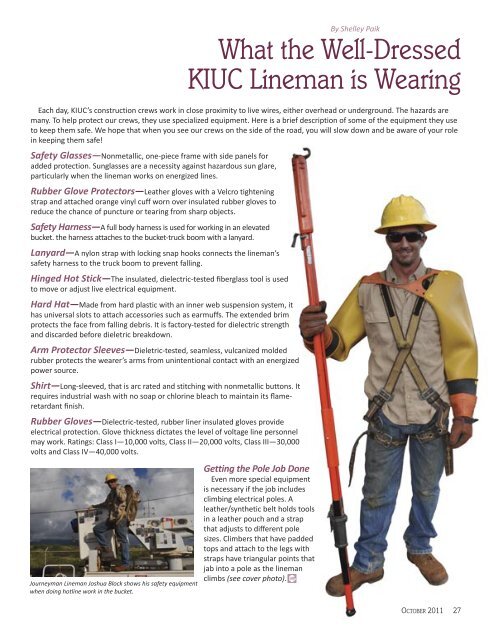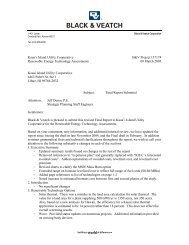KIUC Linemen All Geared Up - Kauai Island Utility Cooperative
KIUC Linemen All Geared Up - Kauai Island Utility Cooperative
KIUC Linemen All Geared Up - Kauai Island Utility Cooperative
You also want an ePaper? Increase the reach of your titles
YUMPU automatically turns print PDFs into web optimized ePapers that Google loves.
By Shelley Paik<br />
What the Well-Dressed<br />
<strong>KIUC</strong> Lineman is Wearing<br />
Each day, <strong>KIUC</strong>’s construction crews work in close proximity to live wires, either overhead or underground. The hazards are<br />
many. To help protect our crews, they use specialized equipment. Here is a brief description of some of the equipment they use<br />
to keep them safe. We hope that when you see our crews on the side of the road, you will slow down and be aware of your role<br />
in keeping them safe!<br />
Safety Glasses—Nonmetallic, onepiece frame with side panels for<br />
added protection. Sunglasses are a necessity against hazardous sun glare,<br />
particularly when the lineman works on energized lines.<br />
Rubber Glove Protectors—Leather gloves with a Velcro tightening<br />
strap and attached orange vinyl cuff worn over insulated rubber gloves to<br />
reduce the chance of puncture or tearing from sharp objects.<br />
Safety Harness—A full body harness is used for working in an elevated<br />
bucket. the harness attaches to the buckettruck boom with a lanyard.<br />
Lanyard—A nylon strap with locking snap hooks connects the lineman’s<br />
safety harness to the truck boom to prevent falling.<br />
Hinged Hot Stick—The insulated, dielectrictested fiberglass tool is used<br />
to move or adjust live electrical equipment.<br />
Hard Hat—Made from hard plastic with an inner web suspension system, it<br />
has universal slots to attach accessories such as earmuffs. The extended brim<br />
protects the face from falling debris. It is factorytested for dielectric strength<br />
and discarded before dieletric breakdown.<br />
Arm Protector Sleeves—Dieletrictested, seamless, vulcanized molded<br />
rubber protects the wearer’s arms from unintentional contact with an energized<br />
power source.<br />
Shirt—Longsleeved, that is arc rated and stitching with nonmetallic buttons. It<br />
requires industrial wash with no soap or chlorine bleach to maintain its flameretardant<br />
finish.<br />
Rubber Gloves—Dielectrictested, rubber liner insulated gloves provide<br />
electrical protection. Glove thickness dictates the level of voltage line personnel<br />
may work. Ratings: Class I—10,000 volts, Class II—20,000 volts, Class III—30,000<br />
volts and Class IV—40,000 volts.<br />
Journeyman Lineman Joshua Block shows his safety equipment<br />
when doing hotline work in the bucket.<br />
Getting the Pole Job Done<br />
Even more special equipment<br />
is necessary if the job includes<br />
climbing electrical poles. A<br />
leather/synthetic belt holds tools<br />
in a leather pouch and a strap<br />
that adjusts to different pole<br />
sizes. Climbers that have padded<br />
tops and attach to the legs with<br />
straps have triangular points that<br />
jab into a pole as the lineman<br />
climbs (see cover photo).<br />
OCTOBER 2011 27
















